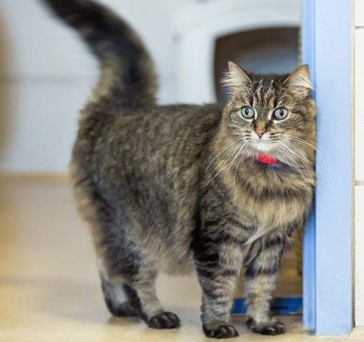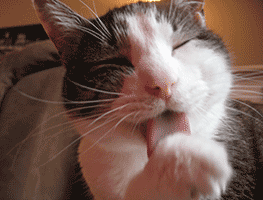Door Dashing
 Door dashing occurs when a curious or adventurous cat attempts to slip out the door as soon as it’s opened. Some of these cats have experienced the outdoor life while others are just curious what may lie beyond the front door, but they can all be very tricky and persistent, making it frustrating to manage at times. Curious and confident cats should be given outlets to explore and engage with novel items, but escaping the home is dangerous and should be prevented. Below are ways to change how your cat behaves when you are entering or exiting your home.
Door dashing occurs when a curious or adventurous cat attempts to slip out the door as soon as it’s opened. Some of these cats have experienced the outdoor life while others are just curious what may lie beyond the front door, but they can all be very tricky and persistent, making it frustrating to manage at times. Curious and confident cats should be given outlets to explore and engage with novel items, but escaping the home is dangerous and should be prevented. Below are ways to change how your cat behaves when you are entering or exiting your home.
Management
First and foremost, it’s dangerous for a cat to slip out of your door. Once loose in the outdoor world, there are many hazards they may encounter that could result in injury or death. And since cats are inherently stealthy, skilled door-dashers can sneak out without you even noticing, making the situation even more hazardous when no one is aware that they’re gone. Therefore, step one of the process is to make physical changes in the home to eliminate or reduce the opportunity for them to sneak out, then you can work on modifying the behavior without worrying about an accidental escape.
- Block access to doors | If your home is set up for it, close doors surrounding your entrances and exits. This will create a second barrier. By always keeping your cat behind the second set of doors, you will be able to enter and exit without risk of your cat slipping outside.
- Barriers/Gates | Many homes do not have doors already present to allow you to block off entrances and exits. In that case, there are a variety of barriers/gates available to purchase, but be sure you select one that’s extra tall and not something your cat could scale or jump over. If you want something more secure or don’t want to be going over/through a gate, you may also consider temporarily installing a screen door in the interior of your home to prevent access to entryways. Find something that works for you and your cat to create a second barrier blocking the doors.
- Prepare guests/visitors | Communicate with guests ahead of time on how they should enter and exit your home. By providing all visitors with a plan ahead of time, there is less chance that your cat will get an opportunity to slip out.
- Confine to a single room | Create a single room for confinement when you are gone. If your cat is confined to a separate room, they cannot sneak out. This room is not meant to be a punishment, so make sure your cat has all their necessities, such as food, water, litter box, bedding, and toys. We recommend leaving your cat an extra special treat-dispensing toy to work on in the room while you are away. This room can also be used when you are having multiple people coming and going, making it hard to keep other barriers in place. Ideally, this will be a temporary solution while working on modifying your cat’s behavior.
Modifying the Behavior
As with all behavior modification and training practices, your efforts will be the most effective if you understand what is driving the behavior in the first place. By identifying those triggers, you can help provide alternatives and make door-dashing less desirable.
Increase Enrichment
All animals thrive the most when they have their physical and mental enrichment needs met. And while the outdoors certainly provides lots of exercise for the brain and body, they also put cats at high risk of getting hit by a car, contracting a myriad of illnesses, falling prey to a larger animal, getting trapped or entangled, or a number of other hazards. Instead, we should focus on providing them with plenty of opportunities for enrichment inside the home. This doesn’t mean you need to go spend a lot of money on toys – it can be as simple as tossing out a few pieces of crumpled up paper, playing with a cat charmer, leaving out any empty shipping boxes for a day or two, or even just rearranging your furniture every now and then to give them a perch with a new perspective. If your house is a more interesting place, they’ll have less of a desire to leave. See our resource on enriching your cat’s life for more information and ideas.
Spay/Neuter
If your cat has not been spayed or neutered (meaning they can still produce babies), they will be even more interested in going outside. You can greatly reduce this biological drive by having them spayed or neutered. To learn more about low-cost spay/neuter options at WHS, please visit www.wihumane.org/spay-neuter.
Create a Greeting Station
A greeting station is a designated spot where your cat knows to go whenever the door is opened so they can receive positive reinforcement in one form or another. If the cat is eating treats or getting affection at their greeting station, they cannot simultaneously be sneaking out the door.
How to create this behavior
- First, choose a station location. This could be a level of your cat’s cat tree, a small table with a pillow on top, a chair, etc. The goal is to find a location where your cat will be comfortable and is slightly away from the door, but still easy for you to access quickly when moving in and out of the home.
- Once you have chosen the location, build interest by placing high-value treats there for your cat to find. If they especially enjoy physical touch, offer petting and chin scratches when they are spending time at their greeting station. Do this routinely throughout the day for a while so they get a chance to realize this spot is highly desirable.
- Start pairing treats/pets at the greeting station with the door opening. This will require a lot of repetition, so stick with it and be persistent – with time, they’ll learn that if they are in their spot when the door opens, they get a reward.
Begin this process by placing several treats on your cat’s station. Once your cat has reached the station, move towards the door. Only take a few steps. Then go back to feed another couple treats and repeat. Slowly move farther from the station over multiple training sessions until you are placing several treats and walking to your door and opening it while your cat stays on their station snacking on treats. Also, practice entering your home and placing treats on the station as soon as you walk in. If your cat finds petting reinforcing, offer pets along with the treats upon entry. Follow this pattern every time you enter and exit your home and soon your cat will head to their station instead of the door when you are entering or exiting.
While your cat is learning this new skill, continue to use management techniques like barriers. When it comes to door-dashing, a cat slipping out can be dangerous, so take your time to build this behavior before taking down any gates or screens. With patience and persistence, you’ll no longer be tripping over your best friend when you walk in the door and your companion will remain contentedly inside where they’re safest!

